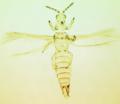Scirtothrips perseae
Recognition data
Distinguishing features
Both sexes fully winged. Body mainly yellow, antecostal ridges of tergites and sternites light brown, tergites III–VII with paired shaded areas anterolaterally; antennal segment I white, II - VIII light brown; major setae light brown; fore wings weakly shaded, clavus dark. Head wider than long; ocellar region with weak and widely spaced lines, postocular region with closely spaced sculpture lines; 3 pairs of ocellar setae present, pair III within ocellar triangle behind fore ocellus. Antennae 8-segmented; segments III–IV with stout forked sensorium. Pronotum with closely spaced sculpture lines; posterior margin with 4 pairs of setae, S2 about 30 microns long. Metanotum with lines of sculpture parallel medially but diverging near posterior margin; median setae well back from anterior margin; campaniform sensilla absent. Forewing first vein with 3–4 setae on distal half, second vein with 3 widely spaced setae; posteromarginal cilia wavy. Abdominal tergites III–VI with median setae small but close together; II–VIII with lateral thirds covered in closely spaced rows of fine microtrichia, these microtrichial fields with 3 discal setae, posterior margins with comb; tergite VIII with comb complete, with discal microtrichia medially; tergite IX without discal microtrichia. Sternites without discal setae; rows of microtrichia present laterally, but not extending mesad of setae S2; posterior margins without comb of microtrichia.
Male smaller than female; tergite IX posterior angles with pair of stout dark drepanae extending around segment X; sternites without pore plates.
Related and similar species
S. perseae differs from the common Californian species, S. citri, in having dark markings on the body, and in having prominent dark drepanae at the apex of the abdomen in males. The genus Scirtothrips currently includes 100 listed species from various parts of the world. Bailey (1964) provided keys to 13 from North America, but that work was based on specimens that were not fully cleared, and thus few structural details were available concerning differences between species. Johansen & Mojica-Guzman (1999) provided keys to 33 species from Mexico, but the validity of many of these seems doubtful, as many were collected from the same plants (Mound & zur Strassen, 2001), and five of them are now recognised as S. perseae (Hoddle, Mound et al., 2008). Hoddle & Mound (2003) provided information on 21 Scirtothrips species from Australia, and Rugman-Jones et al. (2006) produced a molecular key to several pest species in this genus. Relationships of various Scirtothrips species based on molecular data are further considered by Hoddle, Heraty et al. (2008).
Taxonomic data
Current valid name
Scirtothrips perseae Nakahara
Original name and synonyms
- Scirtothrips perseae Nakahara, 1997: 189
- Scirtothrips aguacatae Johansen & Mojica-Guzmán, 1998: 34
- Scirtothrips kupandae Johansen & Mojica-Guzmán, 1998: 47
- Scirtothrips manihotifloris Johansen & Mojica-Guzmán, 1998: 55
- Scirtothrips tacambarensis Johansen & Mojica-Guzmán, 1998: 62
- Scirtothrips uruapaniensis Johansen & Mojica-Guzmán, 1998: 66
Family placement
Thripidae, Thripinae
Common names
Avocado thrips
Biological data
Life history
Breeding on young tissues of leaves and fruits (Hoddle, 2002)
Host plants
Persea americana (Lauraceae) (Hoddle, 2002)
Tospoviruses vectored
None
Crop damage
Feeding on very young fruits causes severe surface damage to avocado fruit.
Distribution data
Area of origin
Mexico and Guatemala
Distribution
Southern California, Mexico, Guatemala







